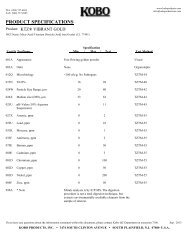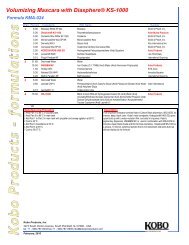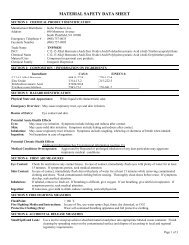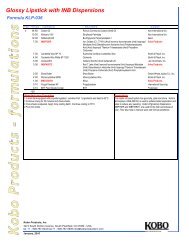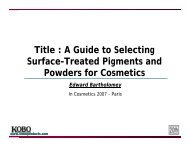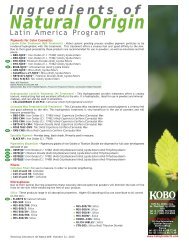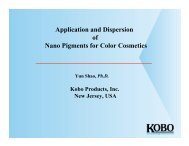Stability Study of Avobenzone with Inorganic Sunscreens
Stability Study of Avobenzone with Inorganic Sunscreens
Stability Study of Avobenzone with Inorganic Sunscreens
- No tags were found...
Create successful ePaper yourself
Turn your PDF publications into a flip-book with our unique Google optimized e-Paper software.
<strong>Stability</strong> <strong>Study</strong> <strong>of</strong> <strong>Avobenzone</strong> <strong>with</strong> <strong>Inorganic</strong> <strong>Sunscreens</strong>Uyen Ngu yen and David SchlossmanKobo Products, Inc. - 690 Montrose Avenue - South Plainfield, NJ 07080I ntroductionT itan iu m diox ide and zinc oxide are pr efer able UV A / UV B sunscreens because <strong>of</strong> their efficiencya nd low ir r itat ion. In or der to i ncr ease th e p r otection in the UV A r ang e, in m a ny count r ies,<strong>Avobenzone</strong> has been u sed in com bin ation <strong>with</strong> titanium dioxide and / or zinc oxide. H owever , int h e US A c om b in a t i on s <strong>of</strong> Av ob en z on e a n d p h y si ca l su n scr een s a r e n ot p er m i t ted.Avoben zon e has been r epor ted to be unstable when con tained in for m ulation s <strong>with</strong> p hysicalsunscr eens. S urface coating <strong>of</strong> the p igm en t has som etim es been sh own to incr ease its stabilityObjectiveIn th is study com binations <strong>of</strong> Avoben zon e and inor gan ic pigm ents wer e ir r adiated in order todeterm in e the influence <strong>of</strong> the pigm en ts an d th eir surface tr eatm ents on stability <strong>of</strong> <strong>Avobenzone</strong>.Sam ple P repara tion0 . 0 4 % A v ob en z on e w a s d i s p e r se d w i t h 4 . 0 % i n or g a n i c p i g m en t i n E t h a n ol .Each sam ple was irradiated (Spectr olin e UV lam ps - XX-15NB) for one week, th en centr ifug edto sep ar ate the solution from the inor ganic pigm ent.All sam ples wer e diluted to 0. 001% w/w Avob enzone based on its initially added am ou nt.Tr ansm ittance and absor bance were m easur ed usin g UV /V is spectroph otom eter (U-3010 fromH itachi).<strong>Avobenzone</strong>OOC 4 H 9OCH 3R eferencesD ev el op m en t <strong>of</strong> T h i n - l a y er S i l i ca - coa t ed Zi n c Ox i d e a n d S u p er i or S u n sc r een s;N. Ishii, K. Wada, M. Takam a, K. Ogawa, K. J oich i and K. OhnoProceed ing XXI IFSCC Internation al Cong ress 2000, Berl in, p. 519P hotocatalytic Activity <strong>of</strong> T itanium Dioxide and Zinc Oxide;M. Kobayashi and W. KalriessCo sm etics & Toiletries, v ol. 112, n o 6, p. 831. Influ ence <strong>of</strong> U ntreated P hysical <strong>Sunscreens</strong> on the <strong>Stability</strong> <strong>of</strong> A vobenzone100806040<strong>Avobenzone</strong> and Untreated PigmentsZ1 A1R1AVOReference Pigment <strong>Avobenzone</strong> remaining Primary particleType after irradiation size (PPS) in nm<strong>Avobenzone</strong> None 100 % -R1 Rutile TiO2 < 1% 200R2 Rutile TiO2 < 1% 200A1 Anatase TiO2 < 1% 300A2 Anatase TiO2 < 1% 300Z1 Zinc Oxide < 1% 35200250 300 350 400 450 500Wavelength (nm)N o sig n i fica n t ch a n g e was ob ser v ed i n t h etr an sm ittan ce <strong>of</strong> Avoben zon e after irr adiation.Un t r eat ed t it a n iu m diox ide a n d z in c ox i dedeg raded <strong>Avobenzone</strong>.Poster A vobenzo ne - SSC N Y2001
2. Influence <strong>of</strong> Treated Titanium Dioxides on the <strong>Stability</strong> <strong>of</strong> <strong>Avobenzone</strong><strong>Avobenzone</strong> With Treated Anatase Titanium Dioxide1008060A1-MSA2-DSA1-SLReference Pigment Treatment <strong>Avobenzone</strong> remainingType Type after irradiationA1-SL Anatase TiO2 Silane 19%A1-MS Anatase TiO2 Methicone < 1%A2-SL Anatase TiO2 Silane < 1%A2-MS Anatase TiO2 Methicone < 1%A2-DS Anatase TiO2 Dimethicone < 1%40AVO<strong>Avobenzone</strong> With Treated Rutile Titanium Dioxide200250 300 350 400 450 500Wavelength (nm)10080R1-SLR1-DS60Reference Pigment Treatment <strong>Avobenzone</strong> remainingType Type after irradiationR1-SL Rutile TiO2 Silane < 1%R2-SL Rutile TiO2 Silane < 1%R1-MS Rutile TiO2 Methicone 38%R1-DS Rutile TiO2 Dimethicone < 1%40200R1-MSAVO250 300 350 400 450 500Wavelength (nm)Com parisons <strong>of</strong> anatase and rutile pigments after treatm ent <strong>with</strong> m ethicone, dim ethicone, and octyltriethoxysilane were m ade.Silane treatm ent: anatase A1-SL gave a better stability.Methicone treatm ent: rutile R1-MS gave a better stability.Anatase A2 had poor stability <strong>with</strong> all treatm ents.<strong>Avobenzone</strong> With Other treatments on Titanium Dioxide1008060R5-SAR4-PFReferenceR3-SCR4-PFR5-SAPigmentTypeRutile TiO2Rutile TiO2Rutile TiO2TreatmentTypeSilicaC9-15 Fluoro-AlcoholphosphateStearic Acid andAluminum Hydroxide<strong>Avobenzone</strong>remainingafter irradiation76%28%3%P.P.S.(nm)90300154020R3-SCAVOOther treatm ents were also evaluated. The silica treatedtitan ium dioxide (R3-SC) g ave the best stability.0250 300 350 400 450 500Wavelengt h (nm)3. Influence <strong>of</strong> Treated Zinc Oxides and Iron Oxides on the <strong>Stability</strong> <strong>of</strong> <strong>Avobenzone</strong>10080604020<strong>Avobenzone</strong> With Zinc OxideZ3-MSZ4-SLZ1-SCZ2-SCAVOReference Pigment <strong>Avobenzone</strong> remaining Primary particleType after irradiation size (PPS) in nmZ2-SC Silica 49 % 25Z1-SC Silica 18 % 35Z3-MS Methicone < 1% 25Z4-SL Silane 3 % 120Treated zinc oxides were evaluated. <strong>Avobenzone</strong> ismore stable <strong>with</strong> the presence <strong>of</strong> Silica treated ZnO.0250 300 350 400 450 500Wavelength (nm)Po ster A vo benz one - SSC N Y2001
ReferenceTreatmentType<strong>Avobenzone</strong> remainingafter irradiation<strong>Avobenzone</strong> <strong>with</strong> Iron OxidesRED-SLYEL-SLBLK-SLSilaneSilaneSilane97 %< 1 %< 1 %10080YEL-SLBLK-SL<strong>Avobenzone</strong> may also be form ulated in make-up products.We evaluated several grades <strong>of</strong> Iron Oxides, in order todetermine if these pigments would impair the activity <strong>of</strong><strong>Avobenzone</strong>. Red iron oxide was found to have a negligibleeffect on the stability <strong>of</strong> <strong>Avobenzone</strong>, while yellow andblack iron oxides, on the contr ary, lead to a com pletedegradation <strong>of</strong> <strong>Avobenzone</strong>.6040200RED-SLAVO250 300 350 400 450 500Wavelength (nm)ConclusionIn the course <strong>of</strong> this study, we have shown that <strong>Avobenzone</strong>, when combined <strong>with</strong> uncoated physicalsunscreens, retains little activity following irradiation.We also dem onstrated that the surface treatm ent <strong>of</strong> pigm ents could lim it this degradation, and in thebest case <strong>of</strong> silica treated Titanium diox ide R3-SC, 76 p er cent <strong>of</strong> the activity was retained.Additional measurements are needed to better understand the UV properties <strong>of</strong> combinations <strong>of</strong> <strong>Avobenzone</strong>and inorganic pigments. Work is in progress in our laboratories to determine the influence <strong>of</strong> the followingparameters :Pigm ent type and m orphology;Extent and type <strong>of</strong> surface treatment;Particle size <strong>of</strong> the pigm ent.The results will need to be correlated <strong>with</strong> approved m ethods for testing sunscreens form ulations.AcknowledgmentThe a uth ors want to th ank Dr. Yun Sh ao for h is tech nica l contribution and Dr. Pascal Delrieu for h istechnical contribution and his art work on this poster.Reference Codes and Trade Nam es <strong>of</strong> Pigments used in this study :Reference codeA1A1-SLA1-MSA2A2-MSA2-DSR1R1-SLR1-MSR1-DSR2R2-SLTrade nameCTFA328BTD-11S2BTD-MS2TiO2 FF PHARMATIO2 FFP-MS2TIO2 FFP-DS4Tronox CR-837RBTD-11S2RBTD-MS2RBTD-DS4CR-834RBTD-834-11S2Reference codeR3-SCR4-PFR5-SAZ1Z1-SCZ2-SCZ3-MSZ4-SLBLK-SLRED-SLYEL-SLTrade nameMAX LIGHT TS-04PF-5 TIO2 CR-50TTO-51-CZNO-350ZNO-350 SIO2(5)MAX LIGHT ZS-032ZNO XZ-MS4A120-ZNO-11S3BBO-11S2BRO-11S2BYO-11S2Poster A vobenzon e - SSCN Y2001



